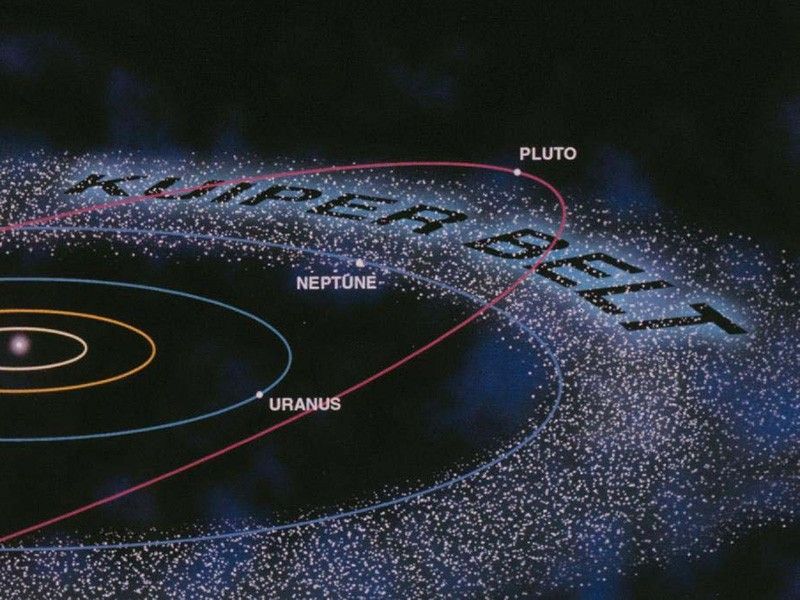Kuiper Belt Pluto Moon: Complete Guide to Pluto’s Mysterious Satellite System

Introduction
The Kuiper Belt Pluto moon system is one of the most fascinating structures in our Solar System.
Located in the icy frontier beyond Neptune, Pluto and its moons offer scientists a window into the early conditions
of planetary formation. These distant worlds are ancient, pristine, and full of geological surprises—making them
key targets for modern astronomy, comparative planetology, and future exploration.
What Is the Kuiper Belt?
The Kuiper Belt is a massive torus-shaped region of icy bodies beyond the orbit of Neptune.
Stretching approximately 30 to 55 AU from the Sun, it is often compared to a distant asteroid belt—though far larger,
colder, and richer in frozen volatiles.
Key characteristics include:
- Billions of icy bodies and dwarf planets
- Home to Pluto, Eris, Haumea, Makemake
- Source of many short-period comets
- Rich in methane, nitrogen, carbon monoxide, and water ice
The Kuiper Belt preserves materials from the early Solar System, making its largest bodies—especially Pluto—ideal
for studying primordial chemistry and planetary formation.
Understanding the Kuiper Belt Pluto Moon System
Pluto hosts five moons forming a unique orbital arrangement:
- Charon
- Nix
- Hydra
- Kerberos
- Styx
Together, they form one of the most remarkable systems in the Solar System. Pluto and Charon orbit a shared
center of mass outside Pluto itself, making them a binary dwarf planet system. This
configuration is unique and essential for understanding how small worlds evolve in the Kuiper Belt.
Charon: The Primary Pluto Moon
Discovered in 1978, Charon revolutionized scientific ideas about Pluto. Nearly half Pluto’s size,
Charon forms a dynamic duo with the dwarf planet.
- Diameter: 1,212 km
- Tidally locked to Pluto
- Displays signs of tectonics and cryovolcanism
- Red polar region likely formed from atmospheric escape from Pluto
Charon is not just a satellite—it is an equal partner in a binary system. The gravitational interplay between the
two bodies remains a subject of active research.
The Smaller Moons: Nix, Hydra, Kerberos & Styx
Pluto’s four smaller moons have unusual shapes, chaotic spins, and reflective surfaces, each offering insights
into the system’s violent past.
Nix
Approximately 50 km wide, highly reflective, and irregularly shaped.
Hydra
The brightest and largest of the smaller moons.
Kerberos
Dark surface and double-lobed “peanut” shape.
Styx
Smallest moon with a diameter of just ~16 km.
These moons are believed to be remnants of the colossal impact that formed Pluto and Charon.
How the Pluto-Charon Binary System Formed
The prevailing theory is that the Pluto-Charon system emerged from a massive collision between
two Kuiper Belt objects over four billion years ago. Debris from this impact eventually coalesced into the
current moons.
This explains:
- The binary nature of Pluto and Charon
- The chaotic orbits of the smaller moons
- The composition similarities among the moons
Why the Kuiper Belt Pluto Moon System Matters to Science
The system is crucial for several research fields, including:
1. Early planetary formation
Pluto preserves materials unchanged since the European Space Agency
2. Binary planetary systems
Pluto and Charon serve as models for studying binary exoplanets.
3. Cryovolcanism and icy geology
Features like nitrogen glaciers and water-ice mountains reveal active geological processes.
4. Atmospheric processes
Pluto’s delicate atmosphere undergoes seasonal changes and nitrogen escape.
5. Kuiper Belt evolution
Studying Pluto provides clues about the broader population of Kuiper Belt Objects (KBOs).
What New Horizons Revealed
NASA’s New Horizons mission provided the first close-up views of the Pluto system in 2015,
transforming scientific understanding.
Major discoveries include:
- Sputnik Planitia, a massive nitrogen-ice glacier
- Signs of recent and ongoing geological activity
- Water-ice mountains reaching several kilometers high
- Atmospheric haze layers and nitrogen escape
- Striking images of Charon’s red polar region
- Detailed views of Nix, Hydra, Kerberos, and Styx
These findings show that even small NASA Science worlds can be surprisingly complex and dynamic.
Future Missions to the Pluto System
Several mission concepts may one day revisit Pluto:
1. Persephone Orbiter
A proposed NASA mission dedicated to mapping Pluto and Charon in detail.
2. New Horizons 2
A follow-up flyby concept targeting additional Kuiper Belt objects.
3. Low-cost CubeSat or SmallSat missions
Advanced miniaturization could make Kuiper Belt missions more feasible.
Conclusion
The Kuiper Belt Pluto moon system remains one of the most scientifically valuable and visually captivating regions
in our Solar System. Pluto, Charon, and their smaller moons preserve ancient materials and reveal processes that
continue to shape icy worlds today.
From binary orbital dynamics to complex geological activity, this system challenges assumptions about what dwarf planets
and small moons can be. Future missions will likely uncover even more groundbreaking discoveries from the frozen edge
of the Solar System.
FAQs About the Kuiper Belt Pluto Moon System
1. What is the Kuiper Belt Pluto moon system?
It refers to Pluto and its five moons located in the Kuiper Belt beyond Neptune.
2. Why is Charon important in the Kuiper Belt Pluto moon system?
Charon is nearly half the size of Pluto, forming a rare binary dwarf planet system.
3. How many moons does Pluto have?
Pluto has five moons: Charon, Nix, Hydra, Kerberos, and Styx.
4. Is Pluto still located in the Kuiper Belt?
Yes. Pluto remains one of the largest known Kuiper Belt objects.
5. What did New Horizons discover about Pluto’s moons?
It revealed irregular shapes, unique surface features, and chaotic rotations.
6. Could life exist on a Kuiper Belt Pluto moon?
While unlikely on the surface, subsurface oceans on Pluto remain possible.
7. Will NASA return to the Pluto system?
Several mission concepts are under study, such as the Persephone orbiter, though none are yet approved.
Si quieres conocer otros artículos parecidos a Kuiper Belt Pluto Moon: Complete Guide to Pluto’s Mysterious Satellite System puedes visitar la categoría Solar System.

Leave a Reply